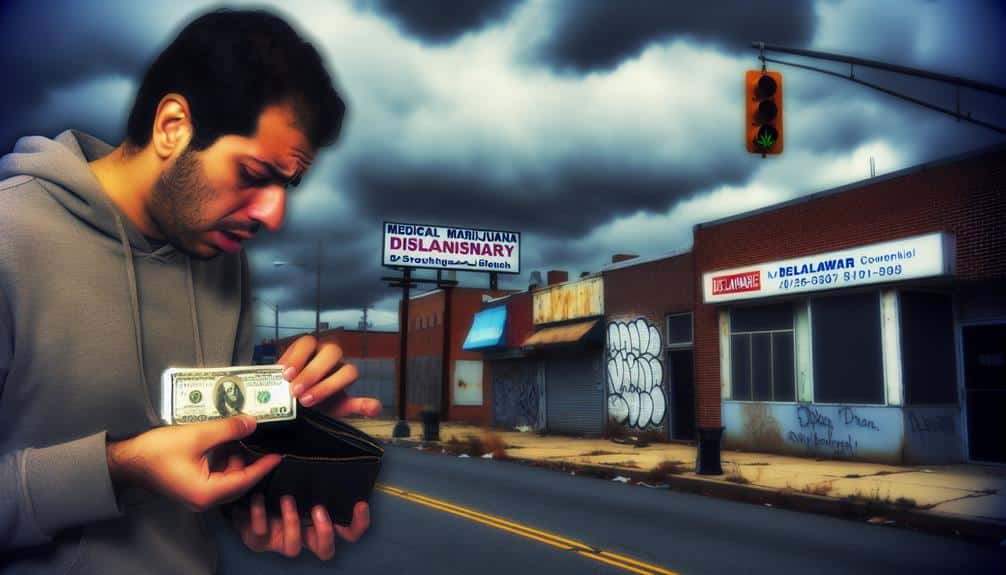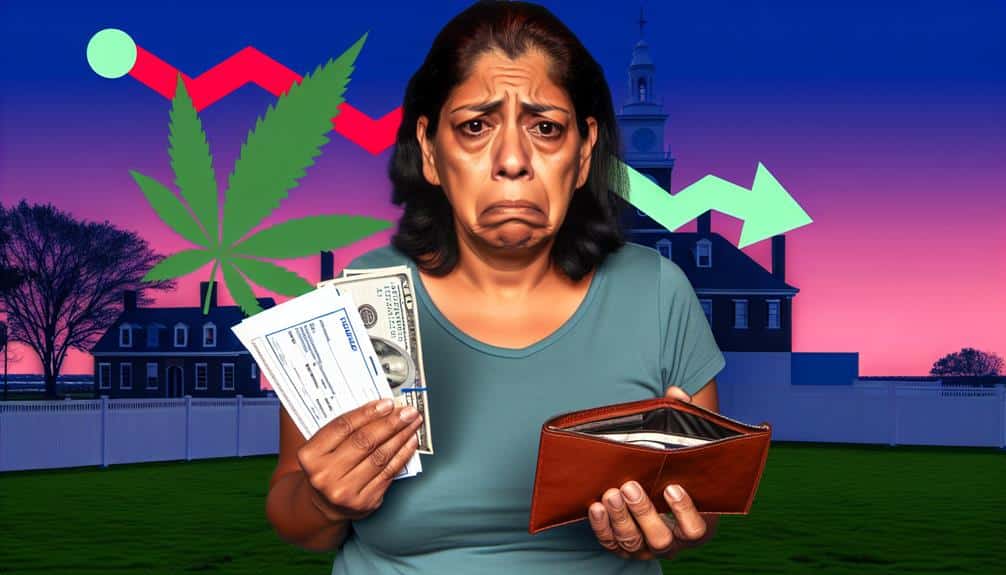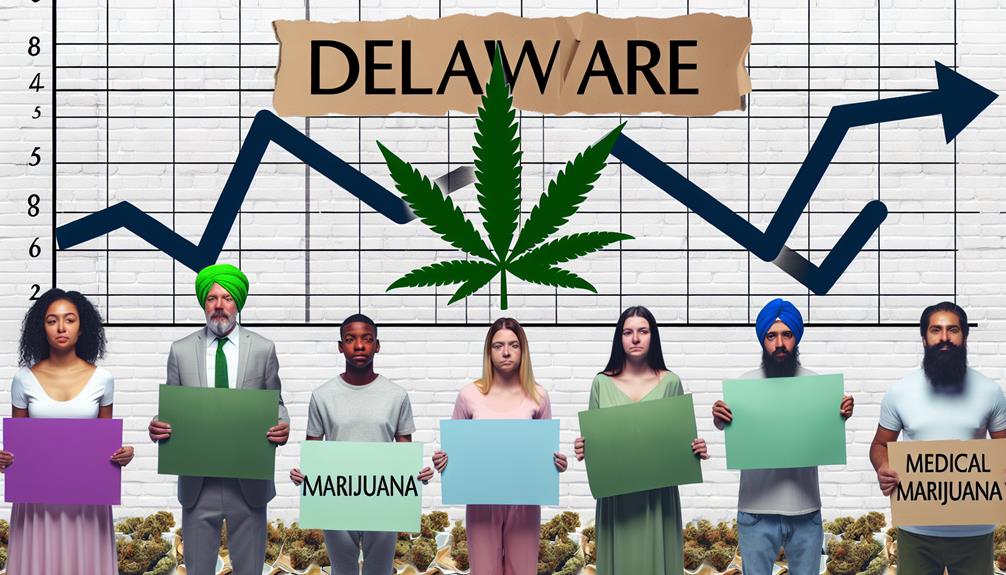In the realm of medical marijuana, Delaware’s economic fluctuations can make accessing this essential medication quite challenging. If you’re directly affected, you’re probably familiar with the obstacles: soaring prices, inconsistent supply, and often confusing regulations. But what if there were potential solutions? What if we could find ways to smooth out this journey, even amidst economic instability? Let’s delve into this together. Unraveling the challenges and exploring possible remedies could be a game-changer, don’t you agree?
Table of Contents
Understanding Delaware’s Medical Marijuana Laws

To navigate Delaware’s medical marijuana laws effectively, it’s crucial to understand their key components and how they impact access during times of economic instability. The legal framework is vital to comprehend as it outlines the rights, restrictions, and requirements for both patients and caregivers.
Patient eligibility is another fundamental aspect of these laws. To qualify for medical marijuana in Delaware, one must be diagnosed with a specific debilitating medical condition such as cancer, HIV/AIDS or PTSD. Additionally, written certification from a physician is required along with proof of residency in Delaware.
However, the law has its limitations. Despite these stipulations many eligible patients still encounter barriers to access. The cost of medical marijuana combined with regular doctor visits can be prohibitive especially during an economic downturn. Furthermore, home cultivation isn’t allowed by law which further limits access.
Understanding these elements of Delaware’s medical marijuana laws is crucial. It enables you to better serve those in need by providing them with accurate information and guidance. By knowing the legal framework and patient eligibility criteria, you’re better equipped to assist those seeking relief through medical marijuana during unstable economic times.
Economic Downturns: Impact on Patients
Economic downturns can significantly impact patients’ finances, especially those relying on medical marijuana for relief from chronic conditions. When the economy stumbles, job loss, wage cuts or reduced working hours can make affording necessary treatments challenging.
Patient education plays a pivotal role in these situations. Understanding economic cycles, their potential impacts on your income and planning accordingly can help maintain your medical routine despite financial turbulence. Staying informed about available resources such as patient assistance programs and nonprofits offering financial aid to cannabis patients is essential.
Economic resilience isn’t just a buzzword; it’s a survival tool. Building a financial buffer and exploring cost-effective alternatives can protect you from the worst impacts of economic downturns. Proactively managing your budget, cutting back on non-essentials and prioritizing the purchase of your medical marijuana is key.
The High Cost of Medical Marijuana

While grappling with financial challenges, the high cost of medical marijuana can further strain your budget. The price tag attached to these essential products often lacks transparency making it even more difficult for you to manage your expenses effectively.
Often, the high cost reflects the stringent quality standards that manufacturers must meet. However, these costs are passed down to you, the patient, exacerbating your economic struggles. The medical marijuana industry’s vague pricing structure often conceals these production costs leaving you with little understanding of what you’re paying for.
A clearer understanding of pricing including what factors contribute to the cost would be beneficial. This transparency could lead to more informed decisions allowing you to better navigate the financial burden of medical marijuana.
There’s a dire need for policy changes that enforce pricing transparency and affordability without compromising quality standards. Achieving this balance would alleviate some of your financial stress and ensure continued access to necessary medical marijuana.
As we continue this discussion, it becomes clear that addressing the high cost of medical marijuana in Delaware requires both systemic changes and individual resilience.
Difficulties in Marijuana Supply Chain
Navigating the complexities of the marijuana supply chain poses another significant challenge especially when already dealing with financial constraints. A fragile supply chain can lead to inconsistent product quality negatively affecting your treatment’s effectiveness.
Maintaining product quality is a complex endeavor. Growers must contend with a range of variables from cultivation to storage which if not managed properly can impact product potency and safety. As a consumer, you may end up paying for a product that doesn’t deliver expected therapeutic benefits.
The supply chain issue also extends to consumer education. Many consumers may not fully understand what they’re buying due to lack of transparency in the supply chain. Are products cultivated under proper conditions? Are they tested for contaminants? Answering these questions is critical for safety and treatment efficacy.
The Plight of Low-Income Patients

Amid these challenges in the supply chain, it’s low-income patients who bear the brunt struggling even more to access medical marijuana. This demographic, already strained by income inequality, grapples with escalating costs. As the economic downturn deepens, their plight intensifies.
Patient discrimination often surfaces in these scenarios. Low-income individuals might not be prioritized in the distribution process leaving them at a disadvantage. The economic barriers erected by a downturn exacerbate already prevalent inequality creating a vicious cycle that needs urgent intervention.
Finding solutions to this issue requires a multifaceted approach. It’s not just about ensuring the supply chain remains robust during economic downturns but also about addressing systemic income inequality that hinders access. Legislative measures and community initiatives can play a vital role in ensuring that low-income patients can afford medical marijuana.
In essence, Delaware’s economic downturn has highlighted the urgent need to address the plight of low-income patients seeking access to medical marijuana. The situation calls for a compassionate and informed response focusing on rectifying patient discrimination and income inequality. Only then can we ensure equitable access for all regardless of their economic status.
Accessibility of Dispensaries in Delaware
In Delaware, both the number and locations of dispensaries play critical roles in medical marijuana accessibility especially for low-income patients. Dispensary locations can either facilitate or hinder patient transportation directly impacting whether patients can access their necessary medication.
It’s important to understand that not all areas in Delaware have equal access to dispensaries. Some regions are underserved forcing patients to travel long distances to procure their medicine. This challenge is amplified for low-income patients who may not have reliable transportation. In such cases, the cost of travel can become a significant barrier forcing some to choose between essential needs and their health.
Moreover, state regulations might limit the number of dispensaries further exacerbating accessibility issues. If a single dispensary serves a large geographic area it can lead to overcrowding and long wait times impeding patient access.
Therefore, when considering solutions both the distribution of dispensaries and the transportation needs of patients should be taken into account. Efforts could include expanding the number of dispensaries in underserved areas or providing subsidized patient transportation. By addressing these issues you can contribute to improving medical marijuana accessibility in Delaware during economic downturns.
Role of Insurance in Medical Marijuana

Understanding the role of insurance in medical marijuana usage is crucial as it directly affects how affordable this treatment is for patients. The nuances of insurance coverage can significantly influence the cost burden of medical marijuana. Typically many insurance companies don’t cover medical marijuana due to its federal classification as a Schedule I substance leaving financial responsibility squarely on the patient making it challenging during economic downturns.
Policy adjustments could potentially alter this landscape. Advocacy at state and federal levels could lead to legislative changes that mandate or incentivize insurance companies to cover medical marijuana. In Delaware where medical marijuana is legal such changes could make a significant difference in patient accessibility.
However, it’s important to recognize that policy adjustments aren’t quick fixes. They require negotiation, compromise and time. In the meantime, patients still grapple with the lack of insurance coverage for medical marijuana. The role of insurance in this issue is complex and far from resolved. This understanding can inform strategies to help those who rely on medical marijuana for their health and well-being. It’s a tough call but one that requires careful consideration and proactive action.
Innovative Solutions for Affordability
Given the economic challenges it’s crucial to explore innovative solutions that can make medical marijuana more affordable for patients. Economic downturns shouldn’t limit your access to medical marijuana especially if it’s a crucial part of your healthcare regime.
There are a few innovative strategies that can help:
- Cannabis Subsidies: State governments could implement cannabis subsidies to lower costs for patients. These subsidies could be funded through tax revenues from recreational marijuana sales making the program self-sustaining and economically viable.
- Bulk Buying Programs: Dispensaries could offer discounts for patients purchasing larger quantities reducing overall cost for regular users.
- Telemedicine Consultations: Virtual consultations could eliminate costs associated with in-office visits making medical marijuana more accessible and affordable.
These strategies aren’t just theoretical; they’re practical, achievable, and could significantly alleviate the financial burden on patients. By implementing these solutions we can ensure that economic downturns don’t prevent patients from accessing the medical marijuana they need.
Community Support and Advocacy

While affordability solutions play a key role, community support and advocacy also significantly impact ensuring medical marijuana is accessible during economic downturns. As a community, you’re in a unique position to drive change through education and advocacy.
Patient education is vital. When you understand the benefits and uses of medical marijuana, you’re better equipped to combat misconceptions and stigma that often accompany its use. It’s not just about knowing the facts; it’s about sharing them too. By educating yourself, you become a credible source of information for others contributing to a more informed and accepting community.
Advocacy training equips you with the skills needed to lobby for better access. You’ll learn how to engage with policymakers effectively use your voice and rally support for the cause. Remember it’s not just about fighting for your rights but also about fighting for those who can’t fight for themselves.
In essence, as a member of the community, you’re also an agent of change. With proper education and training, you can play a crucial role in ensuring access to medical marijuana even in times of economic hardship.
Legislative Reforms: A Potential Solution
Over time legislative reforms could provide potential solutions to improve accessibility of medical marijuana especially during economic downturns. This process isn’t simple as it involves overcoming significant reform obstacles and encouraging policy evolution but don’t let this deter you; it’s a necessary path.
- Addressing Reform Obstacles: These include outdated regulations lack of political will and societal stigma which must be tackled head-on pushing for change at every level.
- Policy Evolution: Advocating for policies that adapt to the times is paramount. This means legislation that not only allows but also supports the use of medical marijuana in treatment protocols especially during periods of financial hardship.
- Consistent Advocacy: This is an ongoing fight. You must remain steadfast building alliances and rallying support to pressure lawmakers into action.
Conclusion
Economic downturns can seriously hamper access to medical marijuana. Interestingly over 60% of Delaware’s medical marijuana patients report affordability as a major roadblock. It’s time to take action – economic planning exploring cost-effective alternatives and pushing for patient assistance programs can help alleviate the burden. Advocacy for legislative reforms could also pave the way for improved access and affordability. The plight of patients shouldn’t be ignored.
I invite you to explore more about this subject and how it directly impacts you. Please consider visiting Doc Greenly at docgreenly.com or giving us a call at (302) 343-2829. We’re here to help, and we genuinely care about your well-being. We believe in the power of informed decisions and are ready to provide necessary resources and support. Your journey towards better health is ours too, and we’re committed to walking it together with you.

